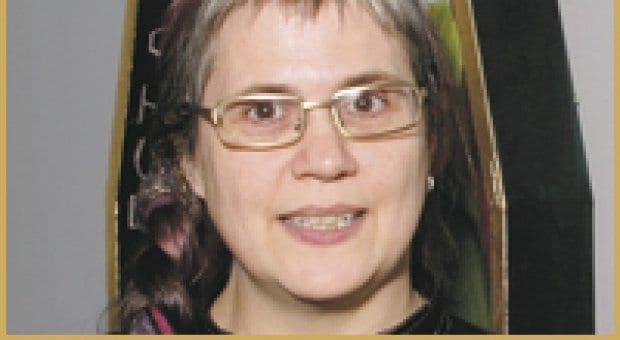Persimmon Blackbridge is determined to lug all her latest work onto the deck of her Hornby Island house to see how it looks together.
She is a large woman-tall and big-boned, with a trademark long braid she wears over one shoulder, black with streaks of red. She’s an imposing presence, especially when she’s carrying her intricate constructions of wood and steel as if they were light and unbreakable.
“You’re too casual with your art,” calls her partner Della McCreary, who is watching from inside. The couple’s two standard poodles are watching too, and whining.
“Everyone’s a critic,” says Blackbridge of the poodles; she doesn’t deny McCreary’s accusation-they’ve obviously been through this before.
Blackbridge has been well known across Canada since the 1980s for her sculpture, her writing and for her performance as part of the Kiss and Tell collective. Her work hangs in the permanent collection of the Vancouver Art Gallery, and her awards include a Lambda Literary Award, the Vancity Book Prize and the prestigious VIVA Award for visual art. A few years ago, Blackbridge retreated to Hornby Island, which is where she has created her latest work.
Blackbridge, together with Elaine Savoie and Suzo Hickey, is part of Mirificus, an exhibit at the Grunt Gallery (through April 1). Blackbridge and Hickey in particular have a history of making art that is specifically queer. But the work in Mirificus explores themes that are both broader and more personal-grief and loss and family identity-and all three artists use explicitly religious imagery to do so.
Blackbridge’s work focuses on her family history of alcoholism, violence and control. The pieces spread across her deck she calls “mixed media photo-based constructions.” Many of them are dioramas, wooden boxes with small figures inside, and photo backgrounds collaged onto the walls. There are many figures made from scans of medieval illustrations of Mary Magdalene and other saints, all with one hand raised.
“Really what that position means is ‘God’s blessings,'” says Blackbridge, “but I see it like one of those hands that goes ‘stop’ in the crosswalk.”
What are the saints trying to stop? Usually it is the generational cycle of pain and suffering: alcoholism, violence, denial. The “stop” figure appears in Do Not Duplicate, a diorama in which figures of Blackbridge’s mother and grandfather stare out at the viewer, each clutching a bottle of vodka to their chest.
Elaine Savoie paints The Madonna and Child, as well as various saints, using the traditional flat icon style-gold halos, flowing robes, symbols from traditional Catholic iconography-except her figures are not people, but crows and chickens.
Savoie also has lots of commissions for paintings of Laya, Patron Saint of Women Wanting Great Sex (with men or women). The chicken-headed saint can be recognized by her emblem: a bowl of cherries. “If you pray to her, it really works,” says Savoie. “I can vouch for that.”
Suzo Hickey describes herself, her partner Emma Kivisild (the curator of Mirificus) and her children Marlon and Jeseka as “obsessed” with Catholic imagery.
Her studio and the rest of her Kitsilano apartment are cluttered with treasures: a glow-in-the-dark statue of St Anthony, a key to heaven, a replica crucifixion nail, a flashing Virgin Mary clock. Hickey’s paintings are full of Catholic imagery too: the sacred heart of Jesus, the immaculate heart of Mary, saints and crosses.
“The Catholic art is what had the long and lasting influence on me,” she says, “and that’s what I’ve passed down on to my kids-not a belief in God, but this love of the wild imagery. And the weirdness.”
Kivisild believes that the issues the artists are tackling require the use of religious imagery. “There’s something about spiritual searching that’s really hard to get at. You could do it without using those religious images but it’s really hard.” The images, she says, provide an essential shorthand in a culture where almost everyone has some familiarity with Judeo-Christian symbols.
Savoie sees her use of Catholic imagery as both inevitable and deliberate. For her, Catholicism is a culture, not a religion, and she believes that there is no such thing as an ex-Catholic. “I don’t think it lets you go.”
She looks up at the haloed, gold-leafed crows and chickens on her wall. “It’s a paradox. I’m celebrating that culture-the beauty of it, the intensity, the mystery. At the same time I’m saying fuck you.”
In 2004, just months after Hickey had agreed to be part of Mirificus, Marlon died of heart failure at the age of 24. At first she thought about backing out of the show, but then she found that painting gave her a way to channel her anger about her son’s death.
Hickey’s past series of paintings have been overtly political and didactic-and queer. Let Me Go Down in the Mud (1997) looked at what it meant to be a lesbian mother; You Fuckin’ Fruit! (1999) tackled homophobia.
When Hickey is asked how being queer affects this new work about grief and loss, she says it doesn’t-and she’s firm on this. And Savoie, though some might call her bisexual, doesn’t seem to feel entitled to any sort of queer identity since her marriage to a man last year. But Blackbridge is clear that her queer identity does come through in this work.
“My family wasn’t particularly homophobic, so I was never beaten for my gender ambiguity. I was just beaten. But the images I create of those experiences are queer images. Girls with Guns [the title of a number of her works for Mirificus] are tough little femmes, girls with no one to turn to. So they ally with each other. They glare out from their cute little middle-class Easter outfits. They don’t fit the sugar and spice story our culture tells, they will never fit, and they are queer to the bone.”

 Why you can trust Xtra
Why you can trust Xtra


